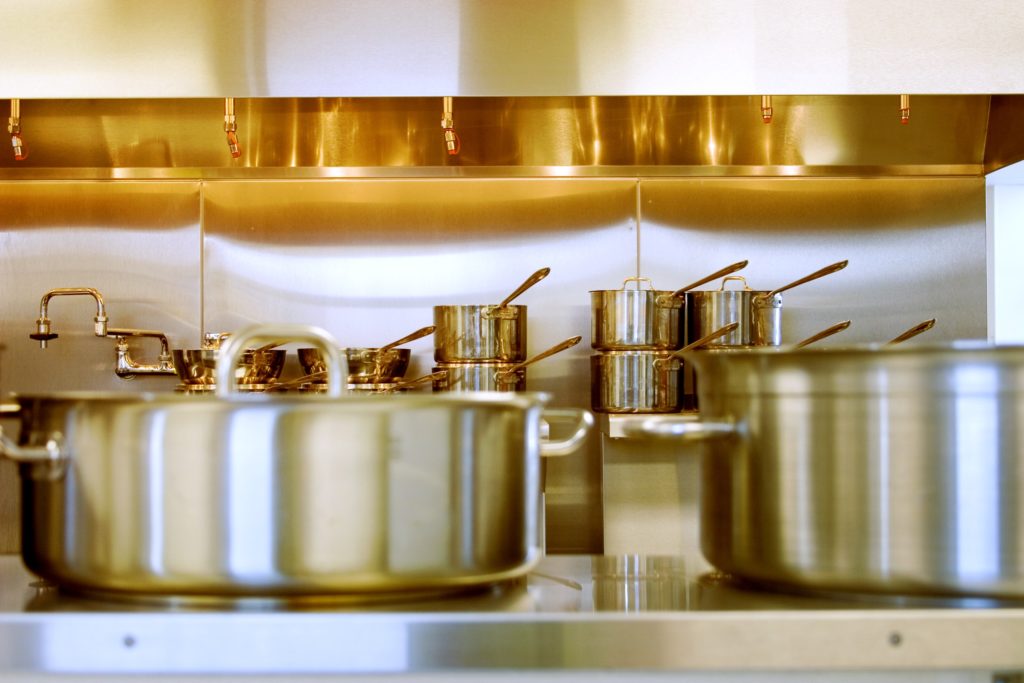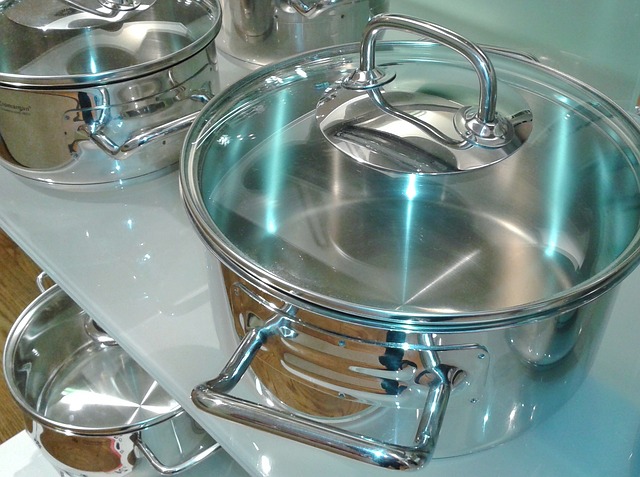How To Remove Hard Water Stains From Stainless Steel Pots And Pans?
If you are using hard water, you must have noticed a build-up of a white substance on your cooking utensils. This means that you need to know how to remove hard water stains from pots and pans.
Stainless steel cookware has multiple benefits but difficult cleaning may be one of few drawbacks. This might seem like an impossible task, especially if the calcium deposits have been on the cookware for some time. You might be frustrated because you feel that your cooking utensils are not clean.
Some people ignore the obvious scum buildup on the cookware, while others find ways of changing the water they use. Some people may not have this option, and others consider it too much work.
The good news is that you can get rid of those mineral deposits. All you need are the right tools.
Here are the steps you can take to remove the calcium buildup on your pots and pans and have them sparkling clean again.
Contents
What causes hard water stains?
Hard water is water that has a high level of dissolved minerals. The most common ones are magnesium, iron, and calcium. One property of water is that it is a good solvent. Therefore, as it finds its way between the soil and rocks, some minerals from these two get into the water.
This solution eventually goes into your water supply. You will not see the minerals after they have dissolved in water, but you can be sure there are lots of minerals in your tap water.
When washing your pots and pans, the water eventually goes down the drain. However, the minerals remain behind. You will now see them in the form of white chalky residue not only on your cookware but also on your glasses. They are also present in your pipes.
Sometimes the mineral deposits can be blue or orange in color.
Related Reading: How To Tell If My Cookware Is Induction Ready
How to remove hard water stains from stainless steel pots and pans?
You can use various techniques to clean the white residue from your pots and pans. Here are some of my favorites.
Use water and vinegar solution
This is the number one method that most people turn to when they see calcium buildup in their cookware. This is because the mix of water and vinegar is effective in getting rid of mineral deposits as well as discolorations.
First, you should assess the level of water stains on your cooking utensils. If there are fewer stains on the cooking gear, then use equal amounts of vinegar and water. If the pots have many mineral buildups, use only vinegar to clean them or use vinegar and less water.
Experts recommend white vinegar to clean the pans because it won’t stink as much as other vinegar types. The second favorite of many is apple cider vinegar.
Put the mixture of vinegar and water on heat and let it boil gently. 15 minutes should be enough for it to simmer. Turn off the heat and allow the solution to cool.
@crazyoilmom6 Stainless steel can get oxidized from hard water and not being properly cleaned. Here’s a quick tip. #naturalcleaning ♬ So Fresh, So Clean – Outkast
After the mixture has cooled, pour most of it into your cookware. You’ll see the stains lifting. You can wipe away any spots that might have been left behind. After the spots are gone, clean your pots and pans as you usually do.
Alternatively, you can soak the cooking utensils in the vinegar mixture.
Repeat the exercise if there are still white spots after following these steps. If you prefer to let the pots soak in the solution, you can leave it overnight to ensure all the hard water stains get off. Then rise the utensils and towel dry.
Related Reading: Stainless Steel Cookware Pros and Cons
Use baking soda
To clean stainless steel cookware with baking soda, make a paste by mixing baking soda and water in a small bowl. Apply the paste to the cookware with a soft sponge or brush and scrub the surface, paying extra attention to any hard water spots or stains.
Let the paste sit for a few minutes, then rinse the cookware thoroughly with warm water and dry it completely with a clean, dry cloth to prevent new water spots.
Use commercial stainless steel cleaners
@bubblesandbuckets Stainless steel sink #barkeepersfriend #cleaningmission #cleaningtips #hardwater #granite #hardwaterstains #cleaningreels #BubblesAndBuckets ♬ Happy Up Beat (Medium) – TimTaj
If you have tried using vinegar or baking soda methods and repeated the process, but there are still stains, you may need to use a commercial stainless steel cleaner. My two go-to cleaners are Bar Keepers Friend Cookware Cleanser & Polish and All-Clad Cookware Cleaner and Polish.
Use Tang
Tang drink mix has a high concentration of ascorbic acid. This acid may be strong enough to eliminate some mineral deposits.
To use Tang to clean hard water spots, you can make a solution by mixing Tang powder with water or dish soap. Apply the paste to the hard water spots, let it sit for a few minutes, then scrub the surface with a soft-bristled brush and rinse it off with warm water.
It’s important to note that Tang is not specifically designed for cleaning, so it may not be as effective as other cleaning methods or commercial stainless steel cleaners.

Use a soft sponge or soft piece of cloth
Stainless steel cookware manufacturers will tell you not to use abrasive cleaning tools like abrasive sponges or steel wool on the pots.
You might be tempted to use harsh abrasives when you see stains on your cooking utensils but don’t do it. This way, you will just damage your utensil and expedite its demise.
Just take a soft sponge or piece of cloth and try to gently remove the calcium deposits that are softened using the methods above.
How to prevent calcium buildup on stainless steel cookware?
Keeping hard water stains away from your pots and pans may seem difficult. However, it is not impossible. These are some of the things you can do to accomplish that.
Keep your cookware dry
Calcium deposits form in moist places. Therefore, you should thoroughly dry your cookware to prevent the formation of white stains.
Clean with solutions that fight calcium buildup
A vinegar and water mix is an excellent solution for cleaning pots and pans. Lemon juice also serves to keep hard water stains away.
Remember to avoid cleaning solutions with harsh chemicals.

Soften your water
If you cannot prevent water stains from getting on your pots, you can consider softening your hard water.
Careful cleaning
Cleaning your pots and pans carefully and never leaving deposits behind will prevent your stainless steel cookware from losing its looks.
Conclusion
Hard water spots and stains on stainless steel cookware can be a pain to deal with, but no worries!
A mixture of baking soda and water or white vinegar and water, or even a commercial stainless steel cleaner, can do the trick. Just remember to test it first, scrub it with a soft-bristled brush, and don’t forget to rinse and dry the cookware afterwards.
With a little bit of effort, those stains will be history! And you’ll have shiny cookware in no time!
Related Articles